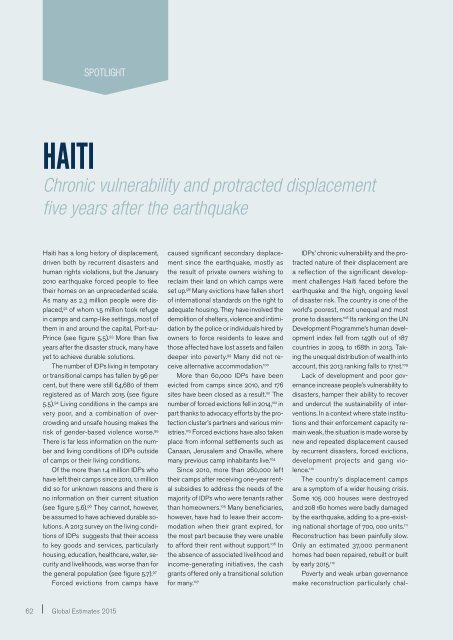Estimates
bzTPL9
bzTPL9
- No tags were found...
Create successful ePaper yourself
Turn your PDF publications into a flip-book with our unique Google optimized e-Paper software.
SPOTLIGHTHAITIChronic vulnerability and protracted displacementfive years after the earthquakeHaiti has a long history of displacement,driven both by recurrent disasters andhuman rights violations, but the January2010 earthquake forced people to fleetheir homes on an unprecedented scale.As many as 2.3 million people were displaced,92 of whom 1.5 million took refugein camps and camp-like settings, most ofthem in and around the capital, Port-au-Prince (see figure 5.5). 93 More than fiveyears after the disaster struck, many haveyet to achieve durable solutions.The number of IDPs living in temporaryor transitional camps has fallen by 96 percent, but there were still 64,680 of themregistered as of March 2015 (see figure5.5). 94 Living conditions in the camps arevery poor, and a combination of overcrowdingand unsafe housing makes therisk of gender-based violence worse. 95There is far less information on the numberand living conditions of IDPs outsideof camps or their living conditions.Of the more than 1.4 million IDPs whohave left their camps since 2010, 1.1 milliondid so for unknown reasons and there isno information on their current situation(see figure 5.6). 96 They cannot, however,be assumed to have achieved durable solutions.A 2013 survey on the living conditionsof IDPs suggests that their accessto key goods and services, particularlyhousing, education, healthcare, water, securityand livelihoods, was worse than forthe general population (see figure 5.7). 97Forced evictions from camps havecaused significant secondary displacementsince the earthquake, mostly asthe result of private owners wishing toreclaim their land on which camps wereset up. 98 Many evictions have fallen shortof international standards on the right toadequate housing. They have involved thedemolition of shelters, violence and intimidationby the police or individuals hired byowners to force residents to leave andthose affected have lost assets and fallendeeper into poverty. 99 Many did not receivealternative accommodation. 100More than 60,000 IDPs have beenevicted from camps since 2010, and 176sites have been closed as a result. 101 Thenumber of forced evictions fell in 2014, 102 inpart thanks to advocacy efforts by the protectioncluster’s partners and various ministries.103 Forced evictions have also takenplace from informal settlements such asCanaan, Jerusalem and Onaville, wheremany previous camp inhabitants live. 104Since 2010, more than 260,000 lefttheir camps after receiving one-year rentalsubsidies to address the needs of themajority of IDPs who were tenants ratherthan homeowners. 105 Many beneficiaries,however, have had to leave their accommodationwhen their grant expired, forthe most part because they were unableto afford their rent without support. 106 Inthe absence of associated livelihood andincome-generating initiatives, the cashgrants offered only a transitional solutionfor many. 107IDPs’ chronic vulnerability and the protractednature of their displacement area reflection of the significant developmentchallenges Haiti faced before theearthquake and the high, ongoing levelof disaster risk. The country is one of theworld’s poorest, most unequal and mostprone to disasters. 108 Its ranking on the UNDevelopment Programme’s human developmentindex fell from 149th out of 187countries in 2009, to 168th in 2013. Takingthe unequal distribution of wealth intoaccount, this 2013 ranking falls to 171st. 109Lack of development and poor governanceincrease people’s vulnerability todisasters, hamper their ability to recoverand undercut the sustainability of interventions.In a context where state institutionsand their enforcement capacity remainweak, the situation is made worse bynew and repeated displacement causedby recurrent disasters, forced evictions,development projects and gang violence.110The country’s displacement campsare a symptom of a wider housing crisis.Some 105 000 houses were destroyedand 208 160 homes were badly damagedby the earthquake, adding to a pre-existingnational shortage of 700, 000 units. 111Reconstruction has been painfully slow.Only an estimated 37,000 permanenthomes had been repaired, rebuilt or builtby early 2015. 112Poverty and weak urban governancemake reconstruction particularly chal-62 Global <strong>Estimates</strong> 2015


